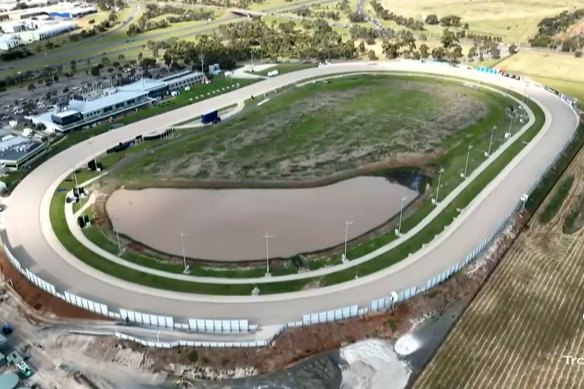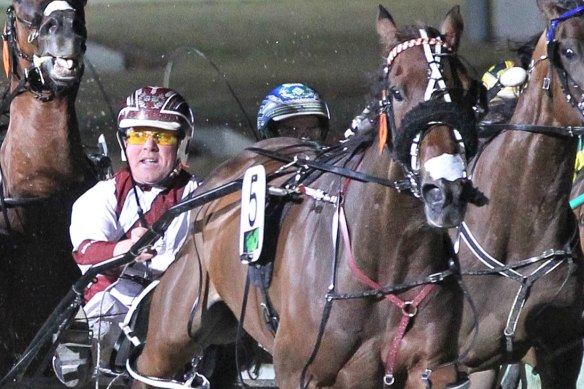This was published 11 months ago
‘Losing millions a year’: The $610 million racing code on the precipice
Victoria’s $610 million-a-year harness racing industry is facing such an “unprecedented crisis” that it is in danger of becoming a rural amateur sport, a group of key stakeholders fear.
The Victorian Harness Racing Kindred Bodies – which represents clubs, trainers and drivers in the state – is so concerned about the sport’s “precarious position” they have organised a save-our-sport rally at Lords Raceway in Bendigo on Sunday.

Melton Entertainment Park, formally Tabcorp Park.Credit: Facebook
“We can’t carry on the way we have been going, losing millions of dollars a year,” leading trainer Anthony Butt said.
“Since 2019, the costs have escalated and the income has stayed the same, so there is a bigger and bigger gap each year between what we are earning and what we are spending.
“In any walk of life, sooner or later, that is going to come back and bite you. If we don’t do something now, it is going to be too late.”
The group says a projected $24 million loss for the 2024 financial year, a huge dip in wagering and expected cuts of more than $10 million in prize money could lead to an exodus of breeders, owners and professional trainers.

Trainer Anthony Butt winning the Hunter Cup in 2013 on Mah Sish.
Since this masthead reported allegations on Sunday that Harness Racing Victoria had lost control of its $100 million Melton land asset, uncertainty over the sport’s professional future has spread.
It comes as HRV chairman Adam Kilgour conceded this week the board would soon sign over its 95-hectare Melton land parcel to the state government.
The board used the Melton land as collateral to borrow more than $40 million from the government in recent years to keep harness racing afloat.
In exchange for the land, the government also agreed to wipe a $41.9 million debt that HRV has carried since buying and building Melton Entertainment Park in 2009. The sport will keep the racecourse facility.
Butt said the fear now was that harness racing in Victoria, which used to be the leading precinct in Australasia, would lose its top-tier professionals, its best horses and its betting appeal, and be reduced to a rural sport for hobby trainers.
“Punters love the name drivers, the name trainers, the big guns,” Butt said.
“They like to back Chris Alford, Greg Sugars, Kate Gath and Kerryn Manning. It’s like we go to a pub on the weekend and we back James McDonald and Jamie Kah [in the gallops]. It’s only natural that the well-known names are going to generate more income.”
Butt, who is president of the Victorian Trainers & Drivers Association, said the government needed to back the sport. He said it made “a hell of a lot of money” from harness racing from taxes, such as the point of consumption wagering tax.
“The industry supports not only the participants but we support farmers who grow the feed, builders, fencers, blacksmiths, vets, horse transporters,” he said.
“We’ve got to buy cars and trucks. We’ve got to put diesel in them because we travel thousands of kilometres a year. There’s a lot of people who make money out of the industry, either directly or indirectly.”
In response to the criticism, Harness Racing Victoria chief executive Matt Isaacs released details of the industry’s revenue and cost challenges on Thursday.
“We simply spend more money to put on the show than we earn, and this has been the case since 2017,” Isaacs said.
“The surplus Melton land was set aside to help the sport in a rainy day, and it’s raining, with harness racing battling for relevancy in a crowded and declining wagering market, and without the crutch of grants from previous years.”
Isaacs said with recent government support that harness racing in Victoria was debt-free and had solvency funding for the next two financial years.
“The sport now needs to transition to standing on its own two feet,” he said.
Isaacs said the sport was cutting $12 million in operational costs, had cut $4.5 million in prize money and was changing the racing calendar – more regular races at bigger regional centres – to encourage more wagering.
Racing Minister Anthony Carbines declined to comment on what the government had planned for the Melton land. He will not be attending Sunday’s rally, which starts at 12.30pm.
RACING VICTORIA LOSS
Racing Victoria has announced it is expecting a $12 million operating loss for the 2024 financial year after a drop of more than 10 per cent in wagering across the past 12 months.
But RV’s newly appointed chief executive officer, Aaron Morrison, said the industry’s governing body had committed to maintaining total prize money levels at $316 million next year.
Morrison said Racing Victoria was looking to make $10 million cuts to operating costs.
It came as RV announced that Flemington would become the new home of the All-Star Mile on Newmarket Handicap Day.
But prize money for the autumn feature race will be slashed from $4 million to $2.5 million.
“Prize money from the All-Star Mile is being diverted to boost maidens and support our picnic circuit,” Morrison said.
The Australian Cup, to be run three weeks after the All-Star Mile, will also be wound back from
$3 million to $2.5 million after the Victorian Racing Committee announced it was reducing prize-money contributions by $1.125 million.
As a result, a total of $475,000 will be cut from three Melbourne Cup qualifying races - the Bagot Handicap, The Roy Higgins and The Andrew Ramsden.
News, results and expert analysis from the weekend of sport are sent every Monday. Sign up for our Sport newsletter.